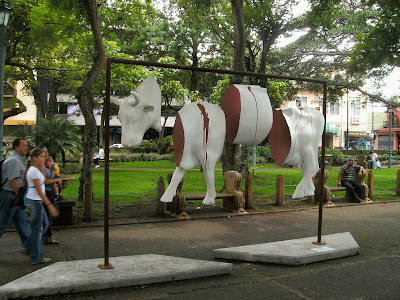
Saturday, July 26, 2008
El Colibrí
Friday, July 25, 2008
George

What I didn't realize until talking to George was how bad the consequences would be if Costa Rica votes not to ratify the treaty. Basically the U.S. government would slap big taxes on all imports coming from Costa Rica and all of the major American companies with factories in the country would move to Nicaragua, eliminating hundreds of thousands of jobs in a country with only a couple million people to begin with.
Mariposas




Thursday, July 24, 2008
Monteverde


Wednesday, July 23, 2008
School Buses
A lot of the vehicles on the roads in Latin America are hand-me-downs from the U.S. and some are so old they'd be eligible for the antique license plates if they were in the States. People really care for their cars here, taking them for regular check ups like you would a child. They close their car doors in the manner you would pat an old friend on the back, and if you don't follow suit people will call you out, especially the taxi drivers. I'm used to closing car doors like I want to make sure they're shut so this was an adjustment for me.

I Hate Tourists
The bus had to stop for a bit on the way to Monteverde from San Jose because the road had been damaged and a pathetic little work crew of four was patching it with a mixture of clay and rock. All the tourists got out of the bus to complain a lot about how the work wasn't getting done quickly enough. Then one of them had the bright idea to offer to help, providing an opportunity to take photos and act righteous. They gave the shovels back to the workmen rather quickly and continued being indignant despite the delay only lasting about thirty minutes. Apparently the industrious vacationers were just more efficient than the Ticos because everyone had been moaning about how the delay would take hours.

Tuesday, July 22, 2008
Amigos Ticos
I met up with a couple of Costa Ricans, Mario (center) and Andrés (right) and they're teaching me all sorts of tico slang. Mario is a 20 year old theatre major and a call center employee who speaks English, French, Spanish, and Portuguese. Andrés is studying massage therapy and is really good at juggling; he's going to work with a group of contact jugglers who get sponsored to juggle big signs with advertisements on them. They're both vegetarian, and they live together in Heredia, a city just outside San Juan. I just cannot get over the kinds of colorful characters you meet while backpacking.

Comida Tica

Monday, July 21, 2008
Vacas



Las Putas de San Jose
Everyone told me Central American capitals suck and I have to say I'm not terribly impressed with Costa Rica's. To be fair it's a Sunday so there's not as much going on. We'll see if it gets any better tomorrow morning but right now I expect I'll head out in the afternoon.

Dear god, never in my life have I seen so many prostitutes. Panama city had a sex tourism problem, San Jose has a sex tourism epidemic. This is the Templo de Musica, according to Lonely Planet widely regarded as "the symbol of San Jose" located in the center of a red light district called Parque España.
Sunday, July 20, 2008
Cloud Forest





Small World

